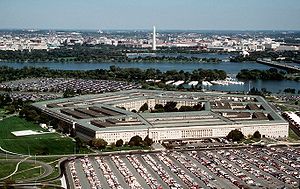Stimson told President Franklin D. Roosevelt in May 1941 that the War Department needed additional space. On July 17, 1941, a congressional hearing took place, organized by Virginia congressman Clifton Woodrum, regarding proposals for new War Department buildings. Woodrum pressed Brigadier General Eugene Reybold, who was representing the War Department at the hearing, for an "overall solution" to the department's "space problem" rather than building yet more temporary buildings. Reybold agreed to report back to the congressman within five days. The War Department called upon its construction chief, General Brehon Somervell, to come up with a plan.[9]

Main Navy Building (foreground) and the Munitions Building were temporary structures built during World War I on the National Mall. The Munitions Building served as the Department of War headquarters for several years before moving into the Pentagon.
The site originally chosen was Arlington Farms which had a roughly pentagonal shape, so the building was planned accordingly as an irregular pentagon.[11] Concerned that the new building could obstruct the view of Washington, D.C. from Arlington Cemetery, President Roosevelt ended up selecting the Hoover Airport site instead.[12] The building retained its pentagonal layout because a major redesign at that stage would have been costly, and Roosevelt liked the design. Freed of the constraints of the asymmetric Arlington Farms site, it was modified into a regular pentagon.[13][14]

Tidak ada komentar:
Posting Komentar